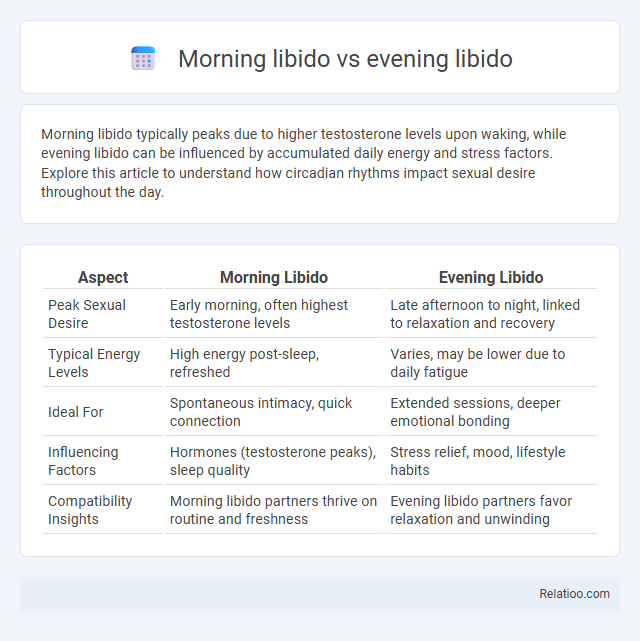Morning libido typically peaks due to higher testosterone levels upon waking, while evening libido can be influenced by accumulated daily energy and stress factors. Explore this article to understand how circadian rhythms impact sexual desire throughout the day.
Table of Comparison
| Aspect | Morning Libido | Evening Libido |
|---|---|---|
| Peak Sexual Desire | Early morning, often highest testosterone levels | Late afternoon to night, linked to relaxation and recovery |
| Typical Energy Levels | High energy post-sleep, refreshed | Varies, may be lower due to daily fatigue |
| Ideal For | Spontaneous intimacy, quick connection | Extended sessions, deeper emotional bonding |
| Influencing Factors | Hormones (testosterone peaks), sleep quality | Stress relief, mood, lifestyle habits |
| Compatibility Insights | Morning libido partners thrive on routine and freshness | Evening libido partners favor relaxation and unwinding |
Understanding Libido: Morning vs Evening
Libido varies significantly between individuals, with morning libido often influenced by hormonal peaks such as elevated testosterone levels upon waking, which can enhance sexual desire and arousal. Evening libido may be affected by factors like daily stress accumulation, fatigue, and circadian rhythms, potentially reducing or increasing sexual interest based on personal energy levels. Understanding these temporal libido fluctuations helps tailor intimate experiences and address sexual health concerns more effectively.
Biological Rhythms and Sexual Desire
Biological rhythms significantly influence libido, with many individuals experiencing peak sexual desire at different times of the day due to hormonal fluctuations such as testosterone levels, which tend to be highest in the morning. Evening libido may be heightened for some because of the relaxation and reduction of daily stressors affecting neurochemical pathways like dopamine and serotonin. Understanding these temporal variations can optimize sexual health by aligning intimacy with natural circadian rhythms and individual hormonal cycles.
Hormonal Fluctuations Throughout the Day
Morning libido is primarily influenced by elevated testosterone levels upon waking, which typically peak in the early hours, enhancing sexual desire. Evening libido varies as cortisol levels drop and melatonin rises, potentially decreasing sexual drive, though some individuals may experience increased arousal due to relaxation and lowered stress. Understanding your hormonal fluctuations throughout the day can help you identify when your libido is naturally higher, optimizing your intimate moments for maximum satisfaction.
Psychological Triggers for Morning and Evening Libido
Morning libido often correlates with higher testosterone levels upon waking, triggering heightened sexual desire driven by physiological and psychological readiness after restful sleep. Evening libido may be influenced by psychological triggers such as stress relief, relaxation, and emotional connection established throughout the day, enhancing sexual interest as a form of unwinding. Understanding these variations highlights the role of circadian rhythms and emotional states in shaping sexual motivation at different times.
Impact of Sleep Quality on Sexual Drive
Sleep quality significantly influences libido, with poor rest often leading to decreased sexual desire regardless of whether libido peaks in the morning or evening. Morning libido tends to be higher due to increased testosterone levels after a full night's restorative sleep, while evening libido may fluctuate more with daily stress and fatigue. Prioritizing deep, uninterrupted sleep enhances hormonal balance and energy, directly boosting overall libido and sexual performance.
Relationship Dynamics: Timing Preferences
Morning libido often aligns with higher testosterone levels, leading to increased sexual desire upon waking, which can enhance relationship satisfaction when partners share similar timing preferences. Evening libido tends to coincide with relaxation and winding down, supporting intimacy through unwinding activities and stress reduction, important for couples with busy daytime schedules. Aligning libido timing preferences fosters better communication, reduces frustration, and strengthens emotional connection in relationships.
Stress, Fatigue, and Their Effects on Libido
Morning libido often reflects healthy testosterone levels but can be diminished by high stress and fatigue, which negatively impact hormonal balance and sexual desire. Evening libido varies based on daily energy expenditure and stress accumulation, with fatigue reducing your capacity and interest in sexual activity. Chronic stress and ongoing fatigue disrupt neurotransmitters and hormone production, leading to decreased libido regardless of the time of day.
Gender Differences in Morning and Evening Arousal
Morning libido tends to be higher in men due to increased testosterone levels upon waking, while women may experience more variable arousal patterns influenced by hormonal fluctuations throughout the day. Evening libido often rises in women as cortisol levels decrease, enhancing relaxation and sexual desire. Understanding these gender differences in morning and evening arousal can help you optimize intimacy and communicate your preferences effectively.
Boosting Libido: Morning and Evening Strategies
Morning libido often peaks due to higher testosterone levels after a night's rest, making it an ideal time for boosting sexual desire with activities like light exercise and a protein-rich breakfast. Evening libido can be enhanced by reducing stress through relaxation techniques, such as meditation or a warm bath, and consuming aphrodisiac foods like dark chocolate or nuts. Tailoring your libido-boosting strategies to your natural rhythm helps maximize your sexual wellness and overall satisfaction.
Aligning Sexual Intimacy With Your Natural Rhythm
Understanding the variations between morning libido, evening libido, and overall libido helps in aligning sexual intimacy with your body's natural rhythm, enhancing satisfaction and connection. Morning libido often peaks due to higher testosterone levels upon waking, while evening libido may increase as stress levels decrease and relaxation sets in. Recognizing these patterns allows couples to schedule intimate moments at times when both partners feel most receptive, promoting a healthier sexual relationship.

Infographic: Morning Libido vs Evening Libido
 relatioo.com
relatioo.com